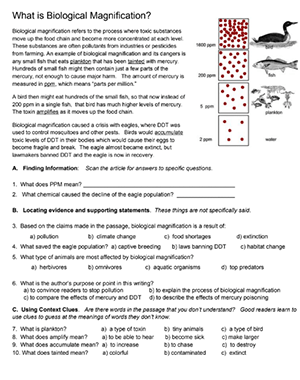
This article discusses how toxic substances accumulate in top predators in an ecosystem, a phenomenon called biological magnification. This accumulation can have dire effects on those populations and can threaten the entire species with extinction.
Students read background information on mercury and DDT and how those toxins are measured in PPM (parts per million). A graphic shows how each trophic level of the food chain accumulates those toxins.
If you use phenomenon based learning you could start by showing images of eagles and their eggs. This historic photo reveals how the shells of the eggs became weak and thin. This resulted in a rapid decline of hatched chicks as a result of spraying DDT on crops.
In this case, I start with a story, I usually make these up with my students but they are based in truth. Two key story points are:
- 1950 DDT becomes widely available
- 1963 Audubon society reports that only 417 eagle nesting pairs remain
- DDT is banned shorty after
- The bald eagle was removed from the Endangered Species List in 2007

Obviously, if you are using this as a phenomenon, you don’t give away the ending. You start with the Thing that happened. Show a photo of a bald eagle and asks students to brainstorm ideas about why the eagle population declined. Then give students the DDT article on biological magnification. Finally, show the photo of the eggs to illustrate the real effects of DDT on bird populations. This is a good time to discuss that it wasn’t just the eagle populations that were experiencing the effects. Many predatory birds were affected by DDT.
Students sometimes have hard time understanding this concept, because they don’t get how the toxin increases as you go up trophic levels. After students read the article, I offer another model that illustrates the concept. I place a bunch of toy fish on my desk and tell students that each fish has 1 particle of DDT in it. Then I use another toy, like a frog and tell them the frog eats 10 fish, then ask how many particle are in the frog? Finally, I use an bird toy (I have lots of toys in my drawer) and ask them what happens when the eagle eats 10 frogs. The answer is that the eagle now has 100 particles of DDT.
This mini-lesson can work with a broad unit on ecology and how humans impact the environment. NGSS requires students to be able to design and evaluate solutions for reducing those impacts. Banning pesticides is one such solution, though it doesn’t come without cost. Farmers had to change to other pesticides, mosquito control was weakened which caused increases in mosquito-borne illnesses like malaria. This worksheet is only meant to be a small portion of a comprehensive unit on ecology.
HS-LS2-7 Design, evaluate, and refine a solution for reducing the impacts of human activities on the environment and biodiversity.*
CCSS.ELA-LITERACY.RST.9-10.1
Cite specific textual evidence to support analysis of science and technical texts, attending to the precise details of explanations or descriptions.

